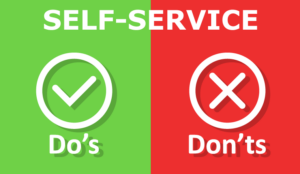Martin Cross of Connect Managed shares four tips for how to boost customer satisfaction and contact centre efficiency by optimising self-service.
There is a good reason why self-service is popular with contact centres: cost. The average salary for a customer services agent in the UK is estimated to be £17,164 (PayScale).
As agents are the single most costly overhead of a contact centre, it makes the optimisation of your self-service capability all the more important.
Self-service used to be viewed by customers in a negative light, often a ‘fend for yourselves’ option with little or no human assistance available.
Today, when done correctly, it’s a way of empowering customers to find the answer themselves in a confident and timely manner that actually improves customer experience.
Perhaps the most important aspect for contact centres is that the customer gets a great customer experience without ever reaching an agent. This frees up the agent’s time to concentrate on more complex customer enquiries.
1. Choosing the Right Type of Query
Any inbound enquiry that requires a simple, transactional, repetitive action, such as paying a bill or submitting a meter reading, should be the first to be considered for self-service.
Introducing it will reduce your inbound call volume and can help improve your customer satisfaction and NPS. To achieve this usually means a transformation programme is required. Using the water industry as an example, typical transactional repetitive actions would include:
- Paying a bill
- Submitting a meter reading
- Reporting a water leak
Before we talk about what type of technology can help you, let’s address a common misconception: your current technology. You may have a mix of technology, with multiple suppliers or old technology that is not fit for purpose.
The misconception is that legacy technology will make new self-service initiatives difficult. But it is now easier than ever to overlay and integrate with new self-service technologies.
2. Always Have the Safety Net of an Agent
Customers always expect the safety net of talking to a human agent. Ideally, agents need to be aware of the interaction history within the self-service before taking a call.
It’s important to ensure that the self-service and agent environments are integrated. This allows appropriate escalation from self-service to an agent.
Too often, customers are asked to repeat information when connecting with an agent, a needless cause of frustration for the customer. Additional training for the agents should be introduced so the handover from self-service to human is seamless.
Remember, if self-service is too cumbersome, you risk customers not wanting to use it. Customers will end up calling your agents anyway. Only now they are already frustrated with the failed self-service experience!
3. Choose the Right Channel at the Right Time
The number of channels that consumers expect to use can somewhat complicate matters. Different channels are often suited to different scenarios. Understanding your customer journey will allow you to pick the perfect channel to deliver self-service for any given process. Channel selection is dependent on:
- Your business
- Customer profile
- Your brand values
- The point that the customer finds the self-service during their journey
In terms of what channels to choose, the website (desktop and mobile), chatbots, SMS and conversational speech assistants are all well worth considering.
4. Utilise Call Avoidance and Call Deflection
Contact centre managers and consultants often tell me about self-service in the context of ‘avoidance’ and ‘deflection’.
Call avoidance is achieved by providing a simple, easy-to-use self-service facility. Customers prefer this so they avoid calling your contact centre altogether. Web forms and mobile apps are often good options here.
Call deflection is achieved by offering customers alternative ways (channels) of completing their transaction once they have already called into the contact centre.
It’s common to play announcements to callers in a queue, stating that the website has the facility to deal with their needs rather than waiting for an agent, but deflecting customers who have already called to another channel (like a web form) is not nearly as effective. It can be frustrating compared to offering self-service on the channel they chose or deflection to a different channel on the same device.
Which Technology Can Optimise Self-Service?
As mentioned earlier, web forms and mobile apps can deliver self-service efficiently and help with call avoidance. Deflecting customers to another channel is not nearly as effective.
Tailoring your customer experience strategy to the customer journey by offering self-service in the channel your customers are using provides a much better customer experience and adoption rate. A deflection to a different channel on the same device should be considered.
How Does Call Deflection Work in Practice?

An example of same-device, different-channel deflection could be:
In either scenario (web link or SMS chatbot), the customer completes the transaction without the need to queue or to speak to an agent. This reduces demand for agents and saves your business money!
Once a customer has successfully used this method and enjoyed the experience, it is likely that the next time they will return to it directly. The initial call ‘deflection’ becomes an ongoing call ‘avoidance’.
Another example of same-device, different-channel self-service is using a speech-based conversational chatbot. Imagine the scenario of a customer calling a contact centre of a utility company to provide a meter reading.


Martin Cross
Of course, if the customer calls in and the system sees that a bill has recently been issued, it will ask them “Are you calling to make payment?”
Each scenario delivers a personalised service each and every time they call in. How better to delight a customer?
Author: Robyn Coppell
Published On: 13th Jun 2019 - Last modified: 19th Jul 2022
Read more about - Guest Blogs, Connect Managed














